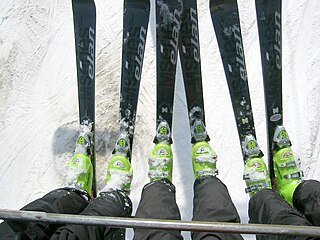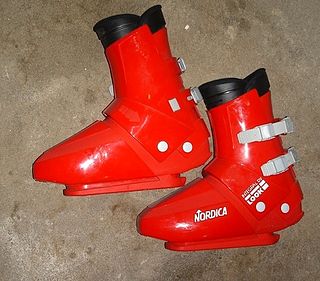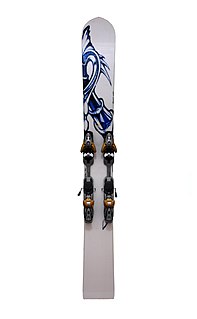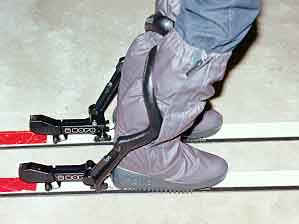 W
WCable bindings, also known as Kandahar bindings or bear-trap bindings, are a type of ski bindings widely used through the middle of the 20th century. It was invented and brand-named after the Kandahar Ski Club in 1929 by ski racer and engineer Guido Reuge. They were replaced in alpine skiing by heel-and-toe "safety bindings" in the mid-1960s.
 W
WThe SCX, for "SideCut eXtreme", was an alpine ski introduced by Elan in the winter of 1993/4. Skis before the SCX had almost always used a shape that was slightly curved inward on the sides, typically by 7 millimetres (0.28 in) compared to a straight line running from tip to tail. The SCX was designed with over 22 millimetres (0.87 in) "sidecut", producing a wasp-waisted ski unlike anything on the market.
 W
WGoggles, or safety glasses, are forms of protective eyewear that usually enclose or protect the area surrounding the eye in order to prevent particulates, water or chemicals from striking the eyes. They are used in chemistry laboratories and in woodworking. They are often used in snow sports as well, and in swimming. Goggles are often worn when using power tools such as drills or chainsaws to prevent flying particles from damaging the eyes. Many types of goggles are available as prescription goggles for those with vision problems.
 W
WA ski helmet is a helmet specifically designed and constructed for winter sports. Use was rare until about 2000, but by about 2010 the great majority of skiers and snowboarders in the US and Europe wear helmets. Helmets are available in many styles, and typically consist of a hard plastic/resin shell with inner padding. Modern ski helmets may include many additional features such as vents, earmuffs, headphones, goggle mounts, and camera mounts.
 W
WThe Look Integral was a downhill ski binding that worked in conjunction with a custom ski boot made by Nordica. The Integral was fairly common in ski rental shops in the 1980s and into the 90s, but has since disappeared.
 W
WLook's Nevada, released in 1950, was the first recognizably modern alpine ski binding. The Nevada was only the toe portion of the binding, and was used with a conventional cable binding for the heel. An updated version was introduced in 1962 with a new step-in heel binding, the Grand Prix. These basic mechanisms formed the basis for LOOK bindings for over 40 years, changing mainly in name and construction materials. The Nevada toe pattern is almost universal among bindings today.
 W
WA monoski is a single wide ski used for skiing on snow. The same boots, bindings, and poles are used as in alpine skiing. Unlike in snowboarding, both feet face forward, rather than sideways to the direction of travel. Similar equipment includes the skwal and the teleboard, with feet in tandem formation.
 W
WThe Nava System was a ski binding and custom ski boot offered for sale in the 1980s. The system used a combination of flexible sole plate to keep the boot centered, and a spring-loaded plastic arm on the rear binding that was used to transmit sideways motions of the leg to the ski. This eliminated the need for a hard shell on the boot; the Nava boot was soft and resembled a knee-high winter boot. In spite of numerous endorsements by racing stars, the system never caught on and sales ended by the late 1980s.
 W
WOutrigger skis are skis that are used by para-skiers to assist with balance, turn, control their speed, stop and amplify the direction of turns. They vary in size and height, and include different features. Depending on the total number of skis used by the skier, outrigger configuration is sometimes called "Three Track Skiing" or "Four Track Skiing". When falling, skiers are taught to move their arms to prevent falling on the outrigger and injuring themselves.
 W
WA piste is a marked ski run or path down a mountain for snow skiing, snowboarding, or other mountain sports.
 W
WA ski binding is a device that connects a ski boot to the ski. Generally, it holds the boot firmly to allow the skier to maneuver the ski. However, if certain force limits are exceeded, it releases the boot to minimize skier injury, such as in the case of a fall or impact. There are different types of bindings for different types of skiing.
 W
WSki geometry is the shape of the ski. Described in the direction of travel, the front of the ski, typically pointed or rounded, is the tip, the middle is the waist and the rear is the tail. Skis have four aspects that define their basic performance: length, width, sidecut and camber. Skis also differ in more minor ways to address certain niche roles. For instance, skis for moguls are much softer to absorb shocks from the quick and sharp turns of the moguls and skis for powder are much wider to provide more "float" in deeper, softer snow.
 W
WSki poles, also referred to as poles, sticks (UK), or stocks (Australia), are used by skiers for balance and propulsion. Modern ski poles are most commonly made from aluminum and carbon fiber, though materials such as bamboo are still used. Poles are used in alpine skiing, freestyle skiing, and cross-country skiing. Ski jumpers do not use poles.
 W
WClimbing skins are strips that attach to the bottom of nordic, alpine touring or randonnée skis to help while ascending backcountry slopes. They are designed to be removed for skiing downhill. They are typically attached to the skis via a loop on the ski tip, a hook on the tail, and adhesive on the base of the skin. They are called skins because they resemble sealskin, from which the first ski skins were made. They are typically made from nylon or mohair or a combination thereof, and are designed to let the ski slide forward on snow but not backward. They are usually narrower than the ski to allow the ski edges to get a grip. Some ski resorts permit skinning.
 W
WA ski suit is a suit made to be worn over the rest of the clothes when skiing or snowboarding. A ski suit made for more casual winter wear outdoors may also be called a snowsuit [ˈsnoʊˌsut] and are often used by children as everyday outerwear in the winter season. Some suits are specifically made for snowboarders but most are used by either skiers or snowboarders regardless of the style.
 W
WSki wax is a material applied to the bottom of snow runners, including skis, snowboards, and toboggans, to improve their coefficient of friction performance under varying snow conditions. The two main types of wax used on skis are glide waxes and grip waxes. They address kinetic friction—to be minimized with a glide wax—and static friction—to be achieved with a grip wax. Both types of wax are designed to be matched with the varying properties of snow, including crystal type and size, and moisture content of the snow surface, which vary with temperature and the temperature history of the snow. Glide wax is selected to minimize sliding friction for both alpine and cross-country skiing. Grip wax provides on-snow traction for cross-country skiers, as they stride forward using classic technique.
 W
WSnow grooming is the process of manipulating snow for recreational uses with a tractor, snowmobile, piste caterpillar, truck or snowcat towing specialized equipment. The process is used to maintain ski hills, cross-country ski trails and snowmobile trails by grooming the snow on them. A snow groomer is usually employed to pack snow and improve skiing and snowboarding and snowmobile trail conditions. The resulting pattern on the snow is known as corduroy, and is widely regarded as a good surface on which to ski or ride. Snow groomers can also move accumulated snow made by snow machines as part of a process, called "snow farming".
 W
WSpademan was a type of ski binding, one of a number of "plate bindings" that were popular in alpine skiing during the 1970s. It used a bronze plate screwed into the bottom of the boot as its connection point, held to the ski by a clamp-like mechanism that grasped the side of the plate. Unlike conventional bindings, the Spademan could release in any direction, in response to any force or torque. It provided greatly improved protection compared to contemporary designs, which generally allowed release of the toe to the sides and heel directly forward, keeping the foot attached in any other fall direction.
 W
WA modified version of their alpine counterparts, twin-tip skis are designed to enable a skier to take off and land backward while jumping and to ski backwards (switch) down a slope. The name "twin-tip" comes from the dual shape of the ski. While most alpine skis have a defined, curved-up front end as well as a flat rear end, twin-tip skis have a curved-up tip and tail.